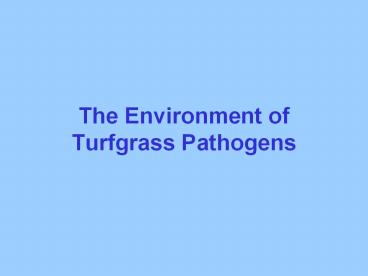The Environment of Turfgrass Pathogens - PowerPoint PPT Presentation
1 / 25
Title:
The Environment of Turfgrass Pathogens
Description:
Title: PowerPoint Presentation Author: Loren J. Giesler Last modified by: Haywood Community College Created Date: 1/29/2003 9:12:29 PM Document presentation format – PowerPoint PPT presentation
Number of Views:72
Avg rating:3.0/5.0
Title: The Environment of Turfgrass Pathogens
1
The Environment of Turfgrass Pathogens
2
HOST PLANT
DISEASE
PATHOGEN
ENVIRONMENT
3
Pathogen Life History
infection
dispersal
2O cycles
colonization
survival
reproduction
4
Pathogen Life History
infection
dispersal
2O cycles
colonization
survival
reproduction
5
GRASS
GRASS PATHOGENS
ENVIRONMENT
LOW DISEASE POTENTIAL
HIGH DISEASE POTENTIAL
6
GRASS
GRASS PATHOGENS
ENVIRONMENT
LOW DISEASE POTENTIAL
HIGH DISEASE POTENTIAL
SEASON WEATHER LANDSCAPE
7
LANDSCAPE EFFECTS
Highly exposed
8
LANDSCAPE EFFECTS
Low air movement
Shading
9
In natural ecosystems, disease is common, but
epidemics are rare
Disease across a population epidemic
Disease on individual plant
10
Turfgrass is prone to epidemics
- Monoculture
- High plant density
Leaf to leaf hyphal growth
11
CANOPY
Two parts of the environment
ROOT ZONE
12
Above-ground environment for pathogens Positive
factors
Nutrients Sugars and amino acids from plant
(wounds), air (pollen), insects (honeydew)
13
Above-ground environment for pathogens Positive
factors
Moisture Atmospheric (humidity) Supports fungal
growth (gt95RH) Prevents dessication Free
moisture (leaf wetness) Needed for spore
germination Bacterial growth and
mobility Nutrient transport Sources dew,
guttation, rain
14
Dew
15
Guttation
16
Above-ground environment for pathogens Negative
factors
Ultraviolet light
- Lethal and mutagenic
- Air movement (wind)
- Causes drying of leaf surface
- Some beneficial effects for
- pathogen, however
- - Evaporative cooling
- - Pathogen dispersal
17
Effects of some cultural practices on canopy
environment
18
Mowing provides wounds Source of nutrients Point
of pathogen penetration
19
Irrigation Lengthens leaf wetness
period Increases canopy humidity Cools leaf
surface
20
By design, turf grass is planted in
high densities. This results in - Reduced
ultraviolet penetration - Reduced leaf
temperatures - Reduced air movement through
canopy - Increased canopy humidity - Increased
leaf wetness period
21
Below-ground environment for pathogens
- Pathogens typically located within top 8 inches
of soil profile - Most are stationary
- Nutrients and host plant must come to pathogen
- Pathogens remain dormant unless provided with
nutrients
22
3
Two parts of the environment
CANOPY
THATCH
ROOT ZONE
23
3
Two parts of the environment
CANOPY
Little to no UV Leaf wetness nearly
continuous Very high humidity
THATCH
ROOT ZONE
24
3
Two parts of the environment
CANOPY
psuedo-root zone
THATCH
Growth and infection by root pathogens!
ROOT ZONE
25
Summary
- Disease epidemics are uncommon in natural stands
of grass - Cultural practices cause turf grass to be prone
to epidemics - Cultural practices modify the environment to be
more consistently favorable to pathogen growth
and infection

